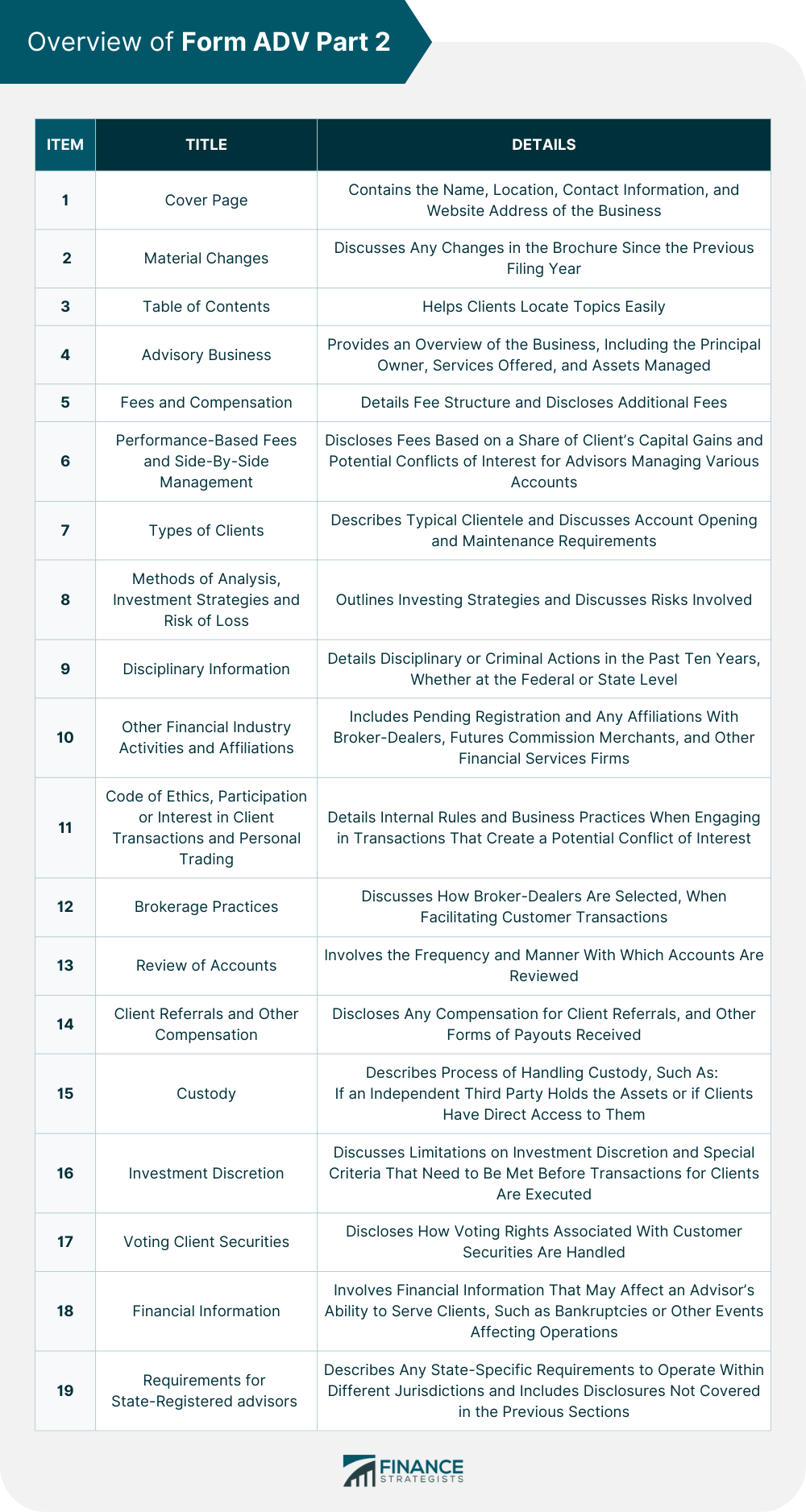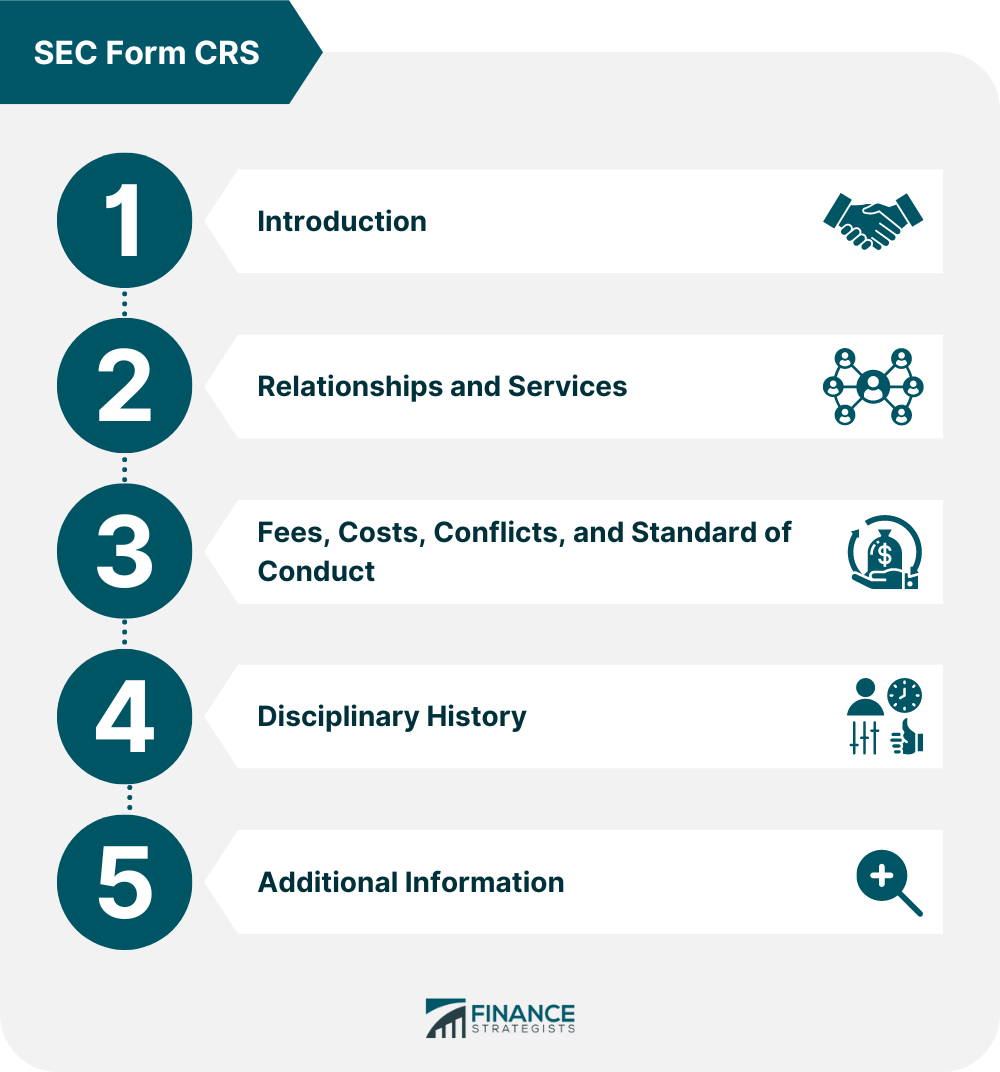Form ADV is a collection of official registration forms filed by investment advisors with the Securities and Exchange Commission (SEC) and their respective state securities authority. It can be downloaded on the SEC’s Investment Advisor Public Disclosure (IAPD) website. This form serves as an initial disclosure document, providing information about registered individuals’ or firms’ practices, services offered, fees charged, background, potential conflicts of interest, disciplinary information, and other important matters related to their operations. Any investment advisor or investment company that manages more than $25 million must complete Form ADV. It is also their responsibility to update it annually and make it available as a public record. Form ADV is a vital disclosure document that provides crucial information about the operations of registered investment advisors. It allows the SEC to monitor and regulate them, ensuring they adhere to all necessary laws and regulations. Form ADV safeguards investors from unethical advisors and helps them make informed decisions. For instance, information on potential conflicts of interest or past disciplinary actions can help an investor assess a potential investment advisor’s competence and trustworthiness. Ultimately, Form ADV is critical in protecting the financial system because it facilitates transparency between advisors and regulators while providing investors with valuable insight into an advisor’s operations. Form ADV Part 1 has Part1A and Part 1B. Both are in a fill-in-the-blank, check-the-box format that requires advisors to provide basic information about their business. Part 1A is the primary disclosure document that all investment advisors must complete. Form ADV Part 1A has 12 items that provide a baseline overview of the advisor's operations. It includes information such as: The table below breaks down the items included in Form ADV Part 1A: Part 1B of Form ADV has two items and must be completed by investment advisors who are registered or registering with any state securities authorities. It contains questions about the advisor’s financial industry affiliations and private fund reporting. Form ADV Part 2 is a detailed brochure investment advisors must submit to the SEC. It contains detailed information about their business operations, services provided, rates charged, and other vital matters. This form is provided to clients to help them understand more about the investment advisor and is easier to navigate than Part 1 because of its narrative format. Investment advisors must update this form on an annual basis. There are two sections of Form ADV Part 2. The investment advisory company's information is disclosed in Part 2A. Part 2B is a supplement section including information on each company employee who gives advice to customers or makes investment choices. Each section must be filled in sequence to standardize filings and make it easy for clients to compare businesses. Part 2A, which contains 19 items, discloses several crucial elements, including: Advisory Business: This part defines the nature of the advisor's firm, including specializations, the clients served, the services offered, and the amount of investment assets managed. Compensation and Fees: Information on the types of fees and compensation accepted by the advisor, such as commissions and the various products or services for which advisors charge a fee, are disclosed. Performance-Based Fees and Side-By-Side Management: The advisor explains their policies on performance-based fees and side-by-side management, as well as any conflicts related to such practices. Investment Strategies and Risks: This section describes the investment strategies employed by the advisor. It also discusses the risk associated with investing in different types of products or services. Disciplinary Information: Advisors must detail any disciplinary or criminal action taken against them by both federal or state securities agencies. Occurrences in the last decade should be explicitly mentioned. Code of Ethics: This section discusses any internal rules the advisor may have regarding their business practices. This includes when an advisor might have a significant financial interest in client transactions, such as investing in the same securities it advises to customers. Brokerage Practices: This section discusses how the advisor selects and creates a broker-dealer for arranging client transactions. Additionally, it details how the advisor handles practices involving soft dollars, customer referrals, trade aggregation, and directed brokerages. Details about each item of Form ADV Part 2 are enumerated in the table below: Form CRS also known as the Relationship Summary, provides condensed information from the previous sections of Form ADV, which details the relationship between investment advisors and their clients. It was formerly considered Part 3 of Form ADV but is now a separate document. The purpose of Form CRS is to provide clients with clear and concise information about registered investment advisors and their services. This form will briefly give potential clients an overview of the services offered, their costs, and what conflicts of interest may arise. Form ADV is accessible to the public, allowing potential clients to view an advisor's background and offerings before they decide to invest. It can be found on the IAPD website. Interested parties can conduct a Form ADV search using the firm's name, location, or Central Registration Depository (CRD) number. Entering this information will generate a page with results. Firms can have multiple listings, so it is essential to check for those with Investment advisor (IA) on their profile to get details about them and their recent filing of Form ADV. Form ADV is an important document investment advisors must file to register with the SEC and their respective state securities authorities. It acts as a disclosure of information about the firm, its services, fees, disciplinary history, and other relevant details that can help potential clients. This form allows the SEC to assess and regulate a registered financial advisor or investment firm. It is intended to protect investors from dealing with firms with poor disciplinary records or a lack of relevant experience. This form currently has two parts. Part 1 is the primary disclosure document that all investment advisors must complete to provide basic information about their business. Part 2 is a narrative brochure that clients can easily navigate, so they understand more about their potential investment advisor. Previously, Form ADV also had a 3rd part. However, in 2019, part 3 was removed and is now a separate document known as SEC Form CRS. Form ADV is available to the public through the IAPD website. Investors should compare the Form ADVs of different investment advisors before selecting one. This way, investors can ensure they have chosen a reliable and trustworthy financial advisor.What Is SEC Form ADV?
Importance of Form ADV
Form ADV Part 1

Form ADV Part 2

Form ADV Part 3: SEC Form CRS

How to Access Form ADV
Final Thoughts
Form ADV FAQs
When reviewing Form ADV, investors should look for information about the investment advisor's experiences in providing services, qualifications, fees, costs incurred when investing with them, risks, conflicts of interest, disciplinary history, and the code of ethics they adhere to.
SEC Form ADV Part 1 is the primary disclosure document all registered investment advisors must complete to provide basic information about their business. Part 2 is a narrative brochure for clients to navigate more efficiently, so they understand more about the investment advisor.
All federally registered investment advisors or firms who manage or advise clients' investments must file a Form ADV with the SEC. Form ADV must be filed annually and updated whenever there is any significant change in the information listed.
The SEC charges an initial registration fee of $40 for those managing less than $25 million, $150 for those handling $25 million to $100 million worth of assets, and $225 for those managing $100 million and above.
Form ADV provides potential investors critical information about an investment advisor's background, such as poor disciplinary records. It also allows the SEC to assess and regulate the suitability of an advisor for potential investors.
True Tamplin is a published author, public speaker, CEO of UpDigital, and founder of Finance Strategists.
True is a Certified Educator in Personal Finance (CEPF®), author of The Handy Financial Ratios Guide, a member of the Society for Advancing Business Editing and Writing, contributes to his financial education site, Finance Strategists, and has spoken to various financial communities such as the CFA Institute, as well as university students like his Alma mater, Biola University, where he received a bachelor of science in business and data analytics.
To learn more about True, visit his personal website or view his author profiles on Amazon, Nasdaq and Forbes.











